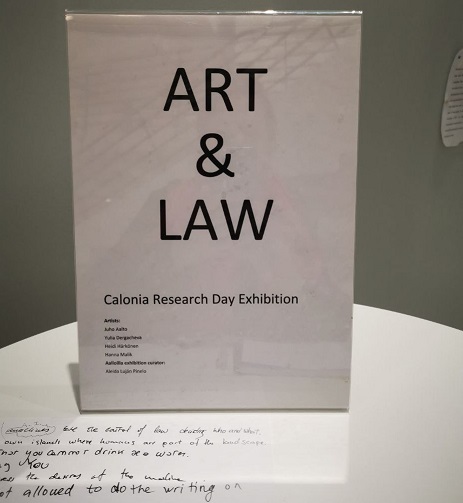Art and Law exhibition
On the Calonia Research Day (2 nd November 2023), the research environment Law, Space, and Justice arranged an exhibition on Art and Law as an introduction to the upcoming Art and Law course.
The course aims at creating new connections between law and art where art plays the role of an embodied knowledge building on law and an embodied expression of law. From this starting point, we will discuss a legal text together and create a piece of art on the topic we discuss. Each lecture will introduce different legal topics and different techniques: collage, watercolor, drawing comics, etc. taught by professional artists.
For the exhibition we asked researchers and teachers to submit their artworks connected with the law. Four artists participated with their artworks: Heidi Härkönen, Juho Aalto, Hanna Malik, and myself. Additionally, Aleida Luján Pinelo curated an interactive exhibition of Law, Space and Justice’s Seili Retreat writings and photographs.
Juho Aalto: Space, human, and environment
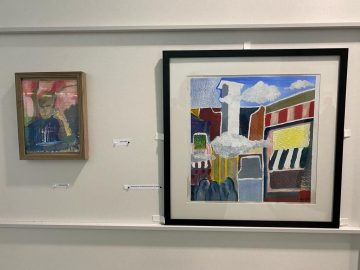
Although we suggested to supplement the artwork with an explanatory text, should the author wish so, Juho preferred not to. Indeed, art often speaks for itself. Juho’s self-portrait with its deep greens and solemn pose might allude to Picasso’s ‘Absinthe drinker’, the study of a human soul in disarray. However, the artist on the self-portrait is poised, focused and self-aware, and the presence of bright, bold pinks on the background speaks of confidence and quiet joy.
A semi-figurative painting of MacDonald’s at Bucharest’s Gare du Nord invites us to the somewhat surreal space where the human-made world, the humans, and the environment are interacting in an unusual way, much like in Chagall’s ‘Vitebsk’. Thus, the clouds are not only up in the sky but also close to the surface, hiding a part of the building from us. The distorted, flat proportions of the buildings and the four silhouetted figures in the corner speak of iconography with its symbolism and reverse perspective, creating a striking contrast with the mundane subject of the painting.
Four abstract figures in the front connect this artwork with Hanna Malik’s ‘Group of souls’ series.
Hanna Malik: To un-law
In her bright and vibrant ‘Group of souls’ series of paintings, Hanna seeks to disconnect with law, which cannot grasp all the complexities present in lives: a journey of a legal scholar and a human.
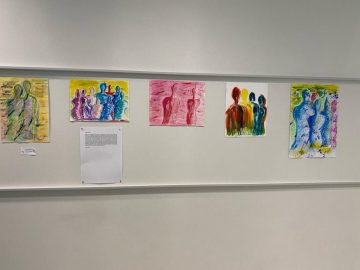
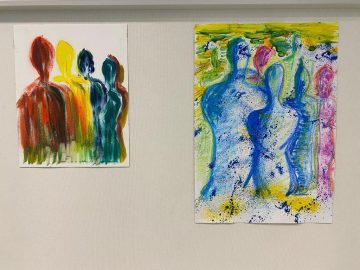
Group of Souls
‘Rather than connecting me to law, this series of paintings is one of my attempts to disconnect from law. In my academic development as a legal scholar, I have been moving further and further away from the rigid categories of criminal law to socio-legal notions such as corporate crime, corporate violence, and social harm. These notions help to capture the complexity and versatility of life. This series, which depicts a group of Souls – Memories of people and experiences that we collect throughout our lives, and that accompany us even though the people, relationships or situations no longer exist – was not painted with law in mind. Still, I see a clear connection between my very primitive, colorful, intense paintings, and the attempt to distance myself from law and legal scholarship in my daily life. By contrast to these colorful depictions, legal categories are in my mind associated with colors black and white, and grey. While the primitiveness or rather openness of these paintings, contrasts with the limiting categories of law and methods of dogmatic legal studies.’
Heidi Härkönen: Connecting art and law
Heidi’s tender and touching artwork in oil pastels is a connection between Heidi’s work as an Intellectual property scholar and an artist creating an object of Intellectual property.
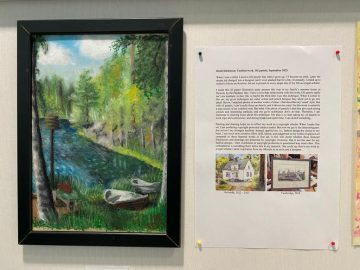
Untitled work. Oil pastels, September 2023.
‘When I was a child, I used to tell people that when I grow up, I’ll become an artist. Later, my dream job changed into a designer (and I even studied that for a bit). Eventually, I ended up in neither of those professions, but art is present in every single day of my life as a legal scholar.
I made this oil pastel illustration early autumn this year at my family’s summer house in Heinola, by the Päijänne lake. I have a love-hate relationship with this work. Oil pastels really isn’t my medium; in fact, this is maybe the third time I use this technique. When it comes to fine art, my go-to techniques are water color and pencil because they allow me to go into detail. Below, I attached photos of another work of mine – that describes my ‘usual’ style. But with oil pastels, I can’t really focus on details, and it drives me crazy! So this work is certainly a step outside of my comfort zone. But what I like about oil pastels is that they give such strong colors and interesting surfaces, and my go-to techniques don’t do that. Therefore, I am interested in learning more about this technique. My plan is to start taking my oil pastels to work trips and conferences, and during breaks and spare time, I can sketch something.
Painting and drawing helps me to reflect my work as a copyright scholar. When I make fine art , I am producing copyright protected subject matter. But now we get to the interesting part: fine art isn’t my strongest medium. Instead, applied art , ie, fashion design the closest to my heart. I use much more creative effort, skill, labor, and judgment to my works of applied art compared to these featured works of fine art. A few will doubt whether these featured illustrations and drawings are protected by copyright. However, that is not the case for my fashion designs – their worthiness of copyright protection is questioned way more often. This contradiction is something that I delve into in my research. One could say that in my work as a legal scholar, I draw inspiration from my lifestyle as an artist and a designer…’
Yulia Dergacheva: In-Between
Rephrasing Marcel Proust’s ‘À la recherche du temps perdu’ my artworks consist of the ‘search of the space lost’ and ‘finding space again’: the law that (dis)connects us in our movements; Finnish nature so resembling Urals nature and yet divided by legal-physical barriers.
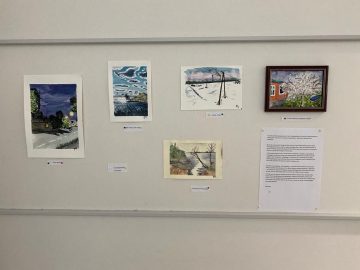
‘I started painting landscapes as a form of appreciation to Finland; a land that took us (reluctantly : D); a form to express my gratitude. I have never painted since childhood.
…
Rarely do I paint other things like this moment in the airport where I got an email from Migri granting my child a residence permit after a one-year battle with the co-parent Refusing to grant permission to the child to leave the country and a 9-months wait for a permit on the basis of family ties.
In the airport transit zone, a weird-lawless-in-between I bought a small bottle of champagne, stretched my legs and celebrated the opportunity to build a new life together with my family – consisting of a kid and a cat – becoming not merely a student going back and forth from the family to studies but a part of people are on the move. We overcame the barrier created to keep us out.
…
My father was building – and Rebuilding – the house of his Dreams for many years before and after his retirement. ‘For all the children and grandchildren; a big warm’ – he used to say. Now all his children and grandchildren live all over the world and he says: ‘We are only happy that no one from our children lives in Russia’.
How did we miss the rise of fascism? Partly I think is because after the fall of the Soviet Union, people became de-politicized. Politicians and politics were out of fashion. We only wanted to have our good private lives as we’ve seen in the movies; we wanted to be good at what we do, to have a house, to travel, to have hobbies and happy families.
…
We failed. ‘
Aalloilla (On the waves): Water, writing, and photography
Aleida Luján Pinelo curated the setting of the Seili texts and photographs and added interactive elements inviting the visitors to contribute to ‘wave-writing’. In this way, Aleida not only showed our Seili project but created an experience for the viewer to be immersed in the co-creation.
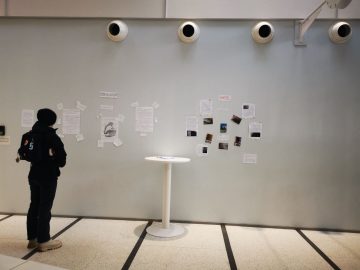
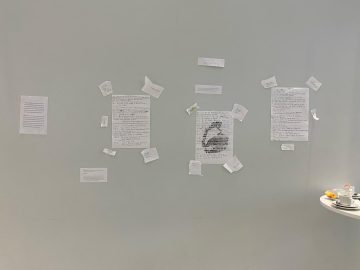
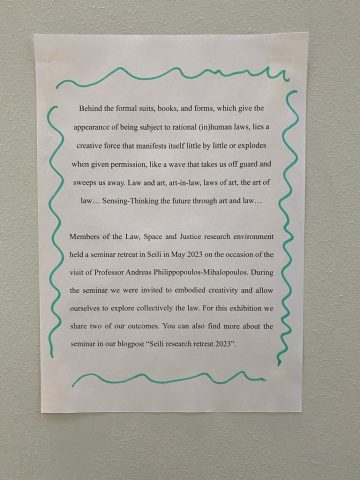
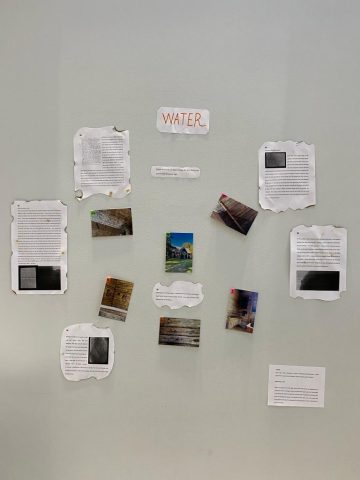
Discussion and feedback
The discussion that followed our exhibition was full of bright ideas. We discussed that the course would not only have learning outcomes, but would also significantly enhance well-being. From the early stages law students are introduced to ‘the grind’ and focus on ‘career-building’. There is little space for reflections. Moreover, the legal profession is very textual. Texts are both our means of production and the product. The Art & Law course will help us to experience law using different means of expression than texts; and to ‘ground’ ourselves.
Another idea was that law is – or can be – a form of art, too. There is a space of creativity within the law. Writing law is often an underestimated creative process. Thus, the barrier that we build between ‘legal’ and ‘creative’ is artificial.
We also explained where the idea of our course came from: firstly, we drew from Andreas Philippopoulos-Mihalopoulos’ Westminster Law and Theory Lab experience. At the Westminster Law School students are asked to produce an artwork on the topic of law and social justice as their final project, which afterwards is exhibited at the Westminster Law Degree Show. Additionally, our colleague, Dr. Kati Nieminen at Helsinki University also provides an opportunity to do an art piece as a final project of her course. However, in these courses the students do not learn to do art; in our course, we will be doing art together with discussions. This was also prompted by the course on gender studies where the students did embroidery simultaneously with discussions on gender justice.
Finally, it seems crucial for us to recruit artists with diverse backgrounds for our teaching sessions. The micropolitics of recruitment matters here: doing critical law should not be limited to writing critique manuscripts.
We hope that the learning environment of the Faculty would overall benefit from our course, which aims at making the learning process more socially sustainable.
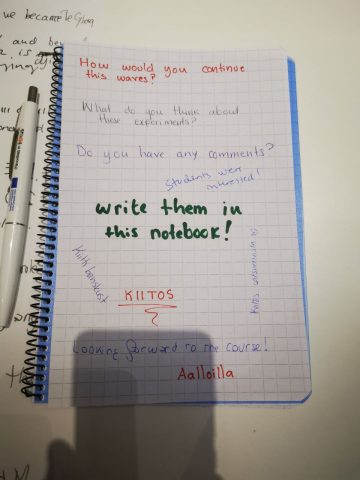
Yulia Dergacheva, artist, legal researcher
Anna Dergacheva, art expert

